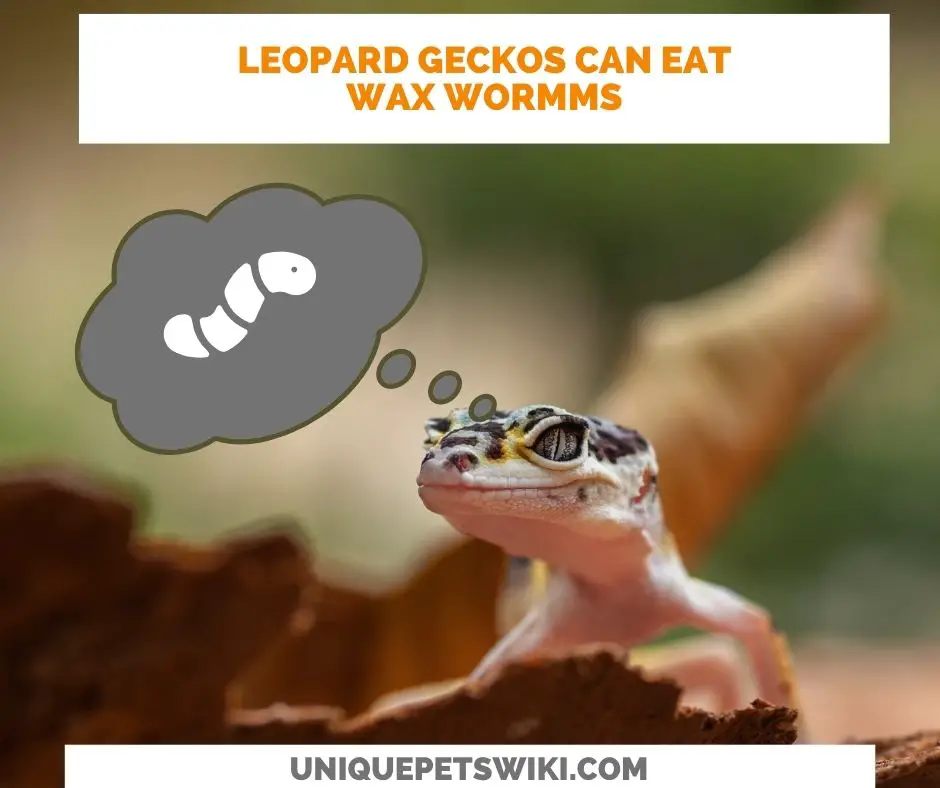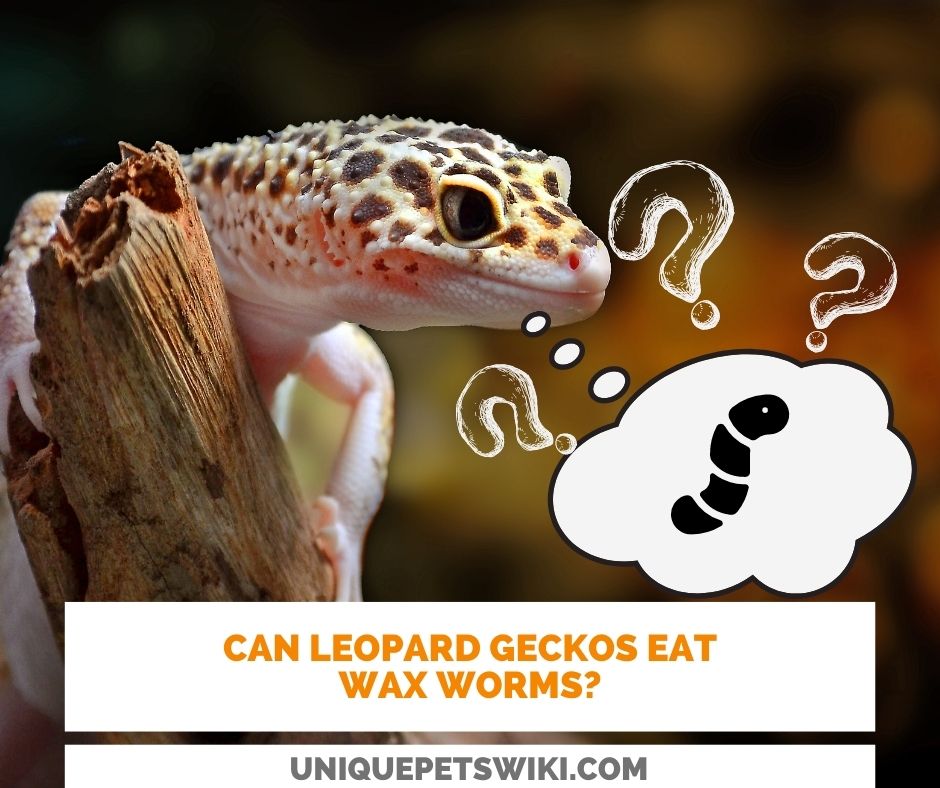Leopard geckos are insectivorous reptiles and will primarily feed on insects. However, there are various feeder insects in the market, and it can be intimidating to find a suitable insect. You may be wondering what the ideal leopard gecko food is perfect for your gecko is.
Just like mealworms, waxworms are not really worms, but they are the larvae of a moth. They are regarded by many keepers to be a useful feeder insect for your gecko but should be fed sparingly. Waxworms are very yummy but can fatten up your geckos, and leopard geckos love them.
In this article, you will learn everything about feeding your leopard geckos with wax worms. You will learn whether leopard geckos love waxworms, how often do you feed your leopard geckos with wax worms, and the feeding schedules.
Contents
- Can leopard geckos eat wax worms?
- Nutritional value of Wax worms
- Do leopard geckos like wax worms?
- Can you feed a leopard gecko with just wax worms?
- How often should I feed my leopard geckos wax worms?
- The table of how many wax worms should leopard geckos eat by their age
- Keeping your wax worms
- Related questions:
- Wrapping Up
Can leopard geckos eat wax worms?

Yes, leopard geckos will eat wax worms. They are strictly insectivorous animals and will eat anything that moves in front of them.
However, you need to feed wax worms to your leopard gecko only as a treat about once a week. Waxworms have a lot of benefits as you can use them to encourage your Leo to start eating. They are also very cheap and easy to find.
You can also use wax worms to build up the fat stored in your leopard gecko if they are underweight or recovering from an illness or tail loss. You can hand-feed your leopard gecko with wax worms to build up their trust.
Nutritional value of Wax worms

Waxworms have high-fat content, and you should only feed it to your gecko on as a treat. Unlike other live foods available in the market, you cannot gut load wax worms, but you can only dust them with calcium supplements before giving them to your Leo.
The nutritional value of wax worms is stated below.
| Nutritional value | Percentage |
| Moisture | 61.73% |
| Fat | 22.19% |
| Protein | 15.50% |
| Fiber | 7.69% |
| Ash | 1.02% |
| Ca ppm 283 | |
| P ppm 2161 | |
| CA/P ratio | 0.131% |
Do leopard geckos like wax worms?
Leopard geckos not only like wax worms; they love them very much. They are a perfect option for your gecko but consist of high-fat content. This is why you should avoid feeding them with too many waxworms as they may turn obese.
Can you feed a leopard gecko with just wax worms?
Nope. You should only feed your leopard geckos with wax worms as an occasional treat. The nutritional content in the worms is poor, and it is best to provide a varied diet for your gecko.
Furthermore, you will need to dust wax worms with calcium powder before you can give your gecko. You should also use wax worms as an occasional treat because your leopard gecko can get addicted to them and refuse all other foods.
How often should I feed my leopard geckos wax worms?
Waxworms have a high-fat content, and overfeeding your leopard geckos with them can lead to obesity. This is why it is best to offer them to your gecko occasionally. Furthermore, avoid introducing wax worms to your leopard gecko before it starts to eat regularly.
You can offer wax worms to your leopard gecko, but they should be considered a treat. Waxworms are high in fat (around 25%), so overfeeding will cause obesity.
You should avoid feeding hatchling leopard gecko until they are up to 4 months old with wax worms. However, you can feed juvenile and adult leopard geckos with 1-3 waxworms one to two times a week.
This will serve as a treat while you feed them with other insect feeders like mealworms or cricket.
The table of how many wax worms should leopard geckos eat by their age
| Leopard Gecko Age(months) | How much do they eat? | How often do they eat? |
| Baby(0 – 4 months) | 0 | 0 |
| Juvenile | 1-3 waxworms | 1-2 times a week |
| Adult | 1-3 waxworms | 1-2 times a week |
Keeping your wax worms
You can store wax worms for a couple of weeks in a fridge with a temperature range between 50-60 degrees Fahrenheit. It is best to store wax worms at room temperature with low humidity than keep them in a refrigerator colder than 40 degrees Fahrenheit in the warmest area.
This is the ideal temperature for slowing down their system and delaying their metamorphosis for some weeks. You should store cupped waxworms in their cup. This is because they are at a stage in their life cycle where they do not consume food and are simply living off the fat supplies in their bodies.
This means they will start to grow smaller the longer that you keep them. Once you remove wax worms from the fridge, they will start wriggling at room temperature after 10 minutes, and you can then feed your Leo.
Fully understanding your leopard gecko will help you better take care of them. As a suggestion, we would recommend you to get a good leopard gecko book. Not to become an expert on leopard gecko care but will help you avoid the common mistake in new pet lizard owners.
Last update on 2022-12-30 / Affiliate links / Images from Amazon Product Advertising API
Related questions:
Why Won’t My Leopard Gecko Eat Wax Worms?
There are situations when leopard geckos can get bored with eating waxworms if you feed them with it consistently. Your gecko may also not eat wax worms if you make a change to their diet. Another reason is that your gecko is sick, or you introduce them to a new environment.
Should I Force-Feed My Leopard Gecko Wax Worms?
Expert hobbyists always advise not to force-feed your leopard geckos. Once you notice that your gecko is not taking to hand-feeding, then you need to see a vet. This is because force-feeding is only used as a last resort, and it requires some expertise to get it right.
Will Wax Worms Cause Fat Leopard Geckos?
Waxworms have high-fat content, which is why leopard geckos love eating them. However, if you feed your leopard geckos primarily on wax worms, it will make them obese.
Wrapping Up
Leopard geckos not only eat wax worms, but they also love it. They are regarded as a useful feeder insect for leopard geckos, but you need to feed it to your gecko only as a treat.

